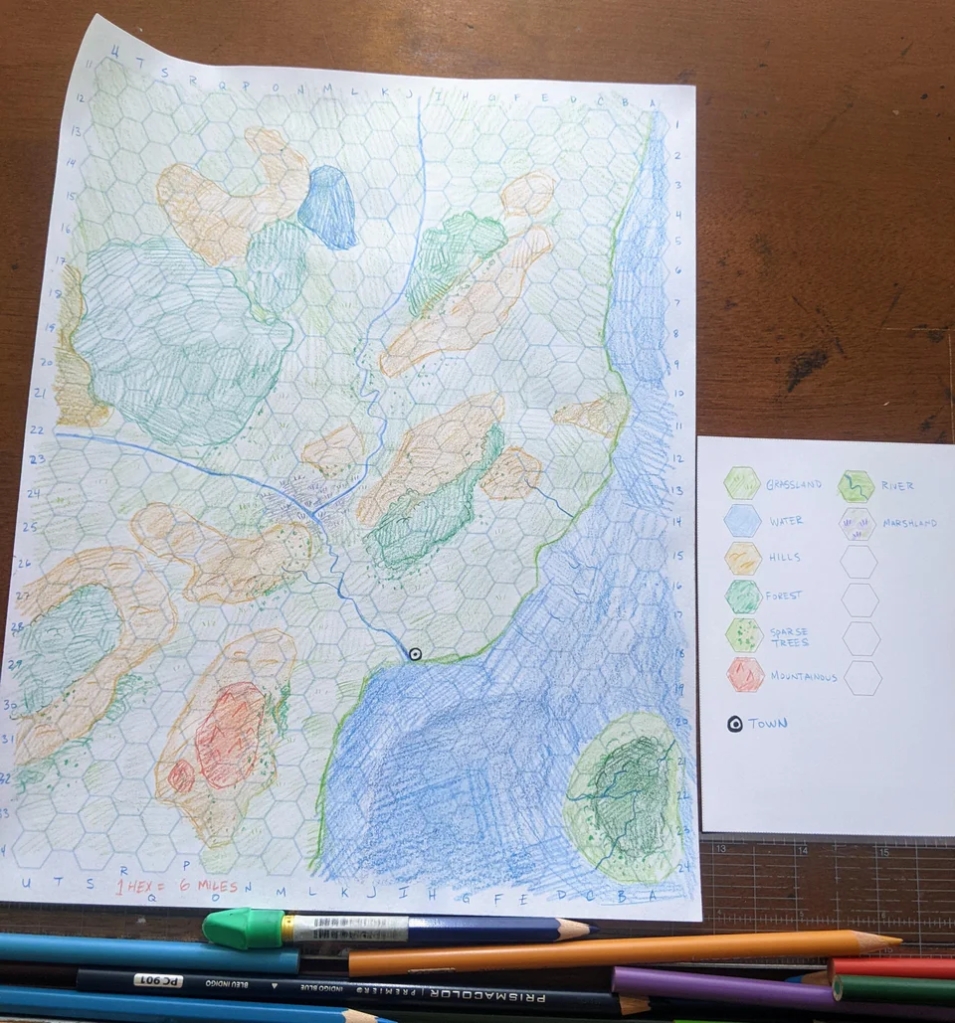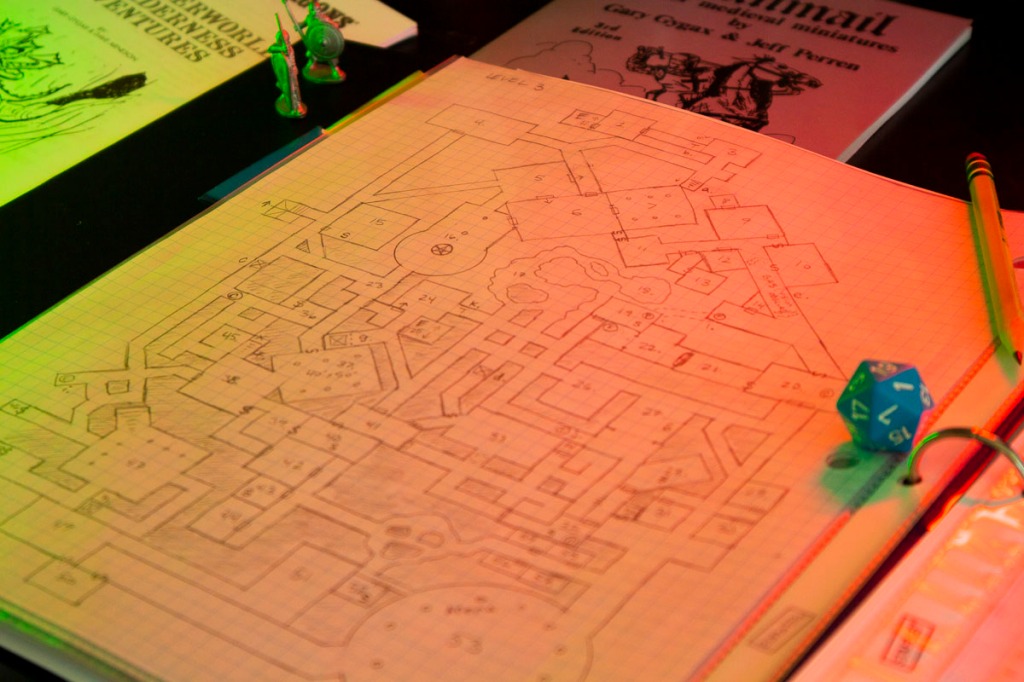This is a follow-up to a reddit post of my week 2 progress on the Gygax 75 challenge. I was inspired to go through the workbook created by Ray Otus which is free to download on itch.io. Ben from Questing Beast posted a video detailing what the challenge entailed, which is when I began. Please excuse the gratuitous use of colored lights some of the photos—I’m trying to get my money’s worth.

If you’re a DM/referee thinking about creating your own campaign setting from scratch, you really should give the Gygax 75 Challenge workbook a go. It’s a great place to start if you’re feeling overwhelmed by the huge task of world building. The workbook does a great job of breaking the whole assignment into manageable chunks and provides some simple prompts to help make useable content. I found once I got to week 3 (in which you’re tasked to create three full levels of a dungeon and stock them)I had momentum to create and I was eager to share.

I’ll preface this post clarifying that the campaign I’m creating through the challenge is for an experimental game I’m planning to run using OD&D with chainmail to resolve combats. I won’t get too detailed on my dungeon layout nor will I reveal too much about the town I’m working on so as not to spoil anything for my players if they read this. It’s experimental because, a) I’ve never run or played with either OD&D or chainmail, and b) I’m hoping to perhaps gain some perspective of how the original creators thought about the game. I’d like to do a write up of using chainmail in a future post, but for now, check out Grey Elf’s Compleat Chainmail. I’ve been reading and rereading this alongside Chainmail 3rd edition and it’s absolutely fascinating.
Week 3
This was my favorite bit. I’ve created hex maps, dungeons, and towns full of NPCs before, but in doing this exercise I was able to look for new tools and approaches to problem solving. For week 3, I decided instead of my typical “automatic drawing” approach to creating dungeons (read, winging it), I opted to use Appendix A from the AD&D dungeon masters guide. In Appendix A, it’s recommended to use one of the “starting areas” offered, but I figured I was creative enough to at least come up with this part on my own. Delta’s D&D Hotspot has a blog post with advice on how to approach using App. A which I would also recommend. Once I got in the flow of using the Appendix A tables I was pumped and ready to just keep making levels, but I decided to leave it at three levels for now. For week 5 I might return and make another dungeon — so much fun.
Here are a couple glamour shots of my dungeon.


For the most part, I stuck with the results that were rolled on the tables—with some minor interpretations here and there. For instance, fairly often I would get a wandering monster result in passages and corridors. In these instances, I would sometimes key these as traps that potentially separated the party or blocked off the passage through sliding walls, portcullis, etc. Occasionally, I did abide by the monster result, but opted for placing a green slime.
For stocking the dungeon, I used OD&D vol. 3 “Distribution of Monsters and Treasure” with some alterations to the monster lists, because I threw in some reskinned creatures and tossed out the ones I didn’t like. Furthermore, I had to do some digging for advice on how to interpret the differences between the number appearing in wilderness vs. in the dungeon. In the paragraph regarding number appearing, I can’t for the life of me understand what EGG is saying (see OD&D vol. 3 “Number of Wandering Monsters Appearing”). Someone on some blog post that I can’t recall to credit them suggested using d6 for determining level appropriate monsters (ie. Skeletons and Spiders on level 1) and then increasing or decreasing that if you get a monster from a Monster Level Table above the current level or below it. That looks fine to me on paper so I’ll play it as that and see if that makes sense in practice.
Week 4
This section was a very illuminating to me—here I learned quite a bit more what the setting was like, much more so than with the dungeon creation and stocking. For the creation of the town map, I went with a tool that I’ve used before and can’t recommend enough — https://watabou.itch.io/medieval-fantasy-city-generator. For my money, it creates the most detailed and “realistic” usable fantasy town layout right out of the box.

Above is the town map that I downloaded from the warabout.itch.io site. I have since imported it into Affinity Designer where I trace over it with the pen tool to make a vector image and then modify the layout and composition slightly by adjusting points. Some of the streets and alleys didn’t make sense to me so I cleaned those up at this stage. The map as is from the generator is totally usable, but I plan to get real noodley with the map and I don’t want to compromise with some of the more peculiar building shapes. I also added the the farmland areas in the outer regions since basically everything outside of the wall is where the peasantry of this city lives and works.
I mentioned that this was the most illuminating stage, and for me this is because once I started pondering each district and where certain shops and businesses are located, I discovered more about the people living in them. For example, there are two ports in two separate districts—one within the walls on the same peninsula that the castle is located and the other is outside the wall, probably the rougher, seedier wharf district. Maybe there’s a rivalry between the sailors and fishermen there. I repeated this line of deduction for every area—asking myself simple questions about the social dynamics and so on. The answers informed me about the political factions, who the overlord is and what they’re like, and even a little about settlements beyond the city.
Thus far, I’ve created at a macro level for the city, but I plan to get further into the weeds on NPCs and their motivations and quirks (as suggested in the workbook), but I feel pretty good about the progress I’ve made and the discoveries along the way. If I had to, I think I know enough about the campaign setting I could run a session which in turn could inform me further about the world.
